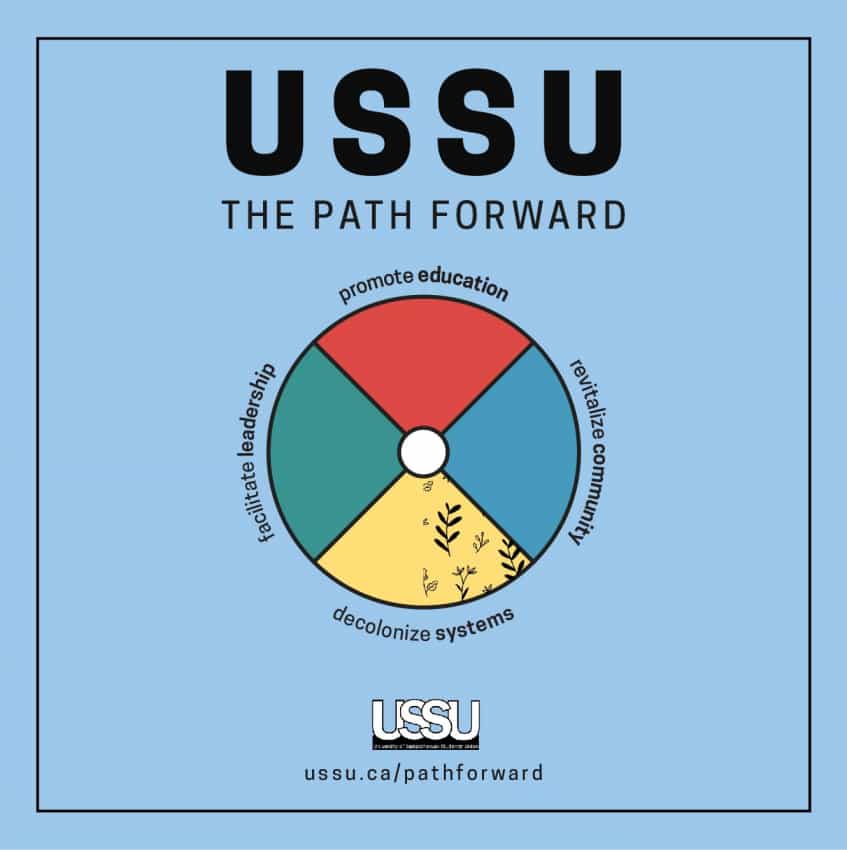
This year, the University of Saskatchewan Students’ Union executive has something new up their sleeves. “The Path Forward” is a set of four broad strategic goals that are intended to shape the union’s activities for the year.
The goals are to promote education, revitalize community, decolonize systems and facilitate leadership. Having strategic goals is not something typically expected of the USSU. The executive worked on drafting the goals over the summer before releasing it to students in late September.
Regan Ratt-Misponas, president of the USSU, says “The Path Forward” will hopefully help students get invested in the USSU’s activities.
“My thinking was that if we had a strategic plan, something that we can all get behind … then it might help us to not only keep organized and keep on the path so to speak, but also to ensure that students saw where we wanted to go,” Ratt-Misponas said.
Ratt-Misponas refers to the goals as “fluid,” meaning that “you can direct them in a lot of ways.” The goals are broad enough that many different issues can be addressed under any of them. Ratt-Misponas thinks that this “gives [them] room to operate.”
In order to promote education, the USSU intends to support students’ rights as they continue to advocate on behalf of students at all levels. For example, this year marks a revival of the Saskatchewan Student Coalition, with Carlos Muñoz Pimentel, vice-president academic affairs of the USSU, as its vice-president. The organization seeks to lobby the provincial government on behalf of post-secondary students.
At the federal level, the USSU is involved with the Undergraduates of Canadian Research-Intensive Universities. Aside from general student advocacy, this organization is notable for having been behind an open letter addressed to the leaders of the federal political parties, signed by the USSU, among many other student unions from across Canada.
To revitalize community, the USSU is focusing on outreach to engage with the student body. The executive is also planning to create opportunities for students to meet with them and share concerns with initiatives such as their continuing Face-To-Face campaign. They hope to create a culture where they encourage and celebrate students’ achievements on campus.
On the front of decolonizing systems, the USSU is aiming to increase conversations and formal relations with Indigenous and Métis communities. They aim to evaluate “how our practices can be improved to be more inclusive and reflective of our campus.” They also intend to hold the university administration and governments accountable in regards to decolonization.
The logo for “The Path Forward” takes the shape of a medicine wheel. Ratt-Misponas says that this is because the USSU wants to “pay respect to the Indigenous people of these lands” and “to show students that we’re looking at this holistically.” The colours on the wheel are the ceremonial colours of the USSU Indigenous Knowledge Keeper Joseph Naytowhow.
“He offered this and allowed us to use his colours that he uses in ceremony,” Ratt-Misponas said.
Finally, to facilitate leadership, the USSU plans to examine the barriers that prevent students from taking on leadership roles. They want to encourage students to participate in the USSU at all levels: in their centres, committees, student council or by becoming an executive member.
When asked about whether or not he thinks that the USSU should continue to have strategic goals in the future, Ratt-Misponas was in favour. He says that the strategic goals help to round out the existing USSU vision, mission and values.
“They complement each other; they almost work together,” Ratt-Misponas said. “I don’t have a say in those years to come … but I do encourage it. I strongly encourage it.”
—
Kienan Ashton
Graphic: Supplied by Joseph Naytowhow/ Made by Mỹ Anh Phan